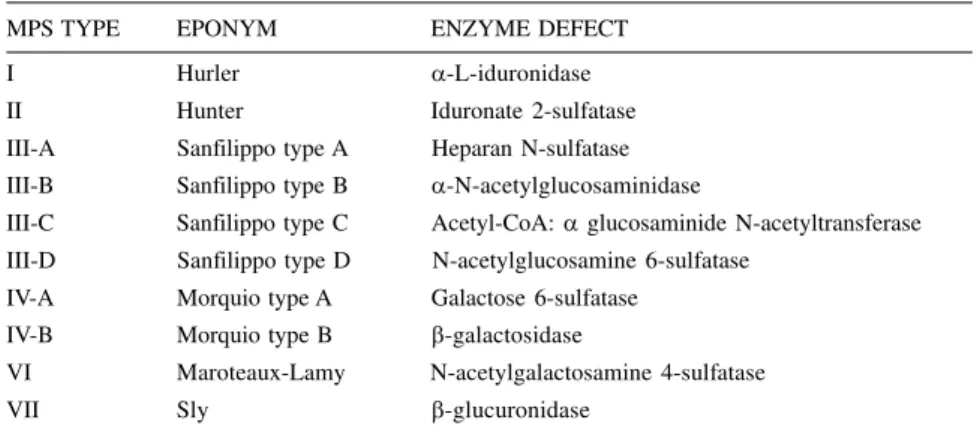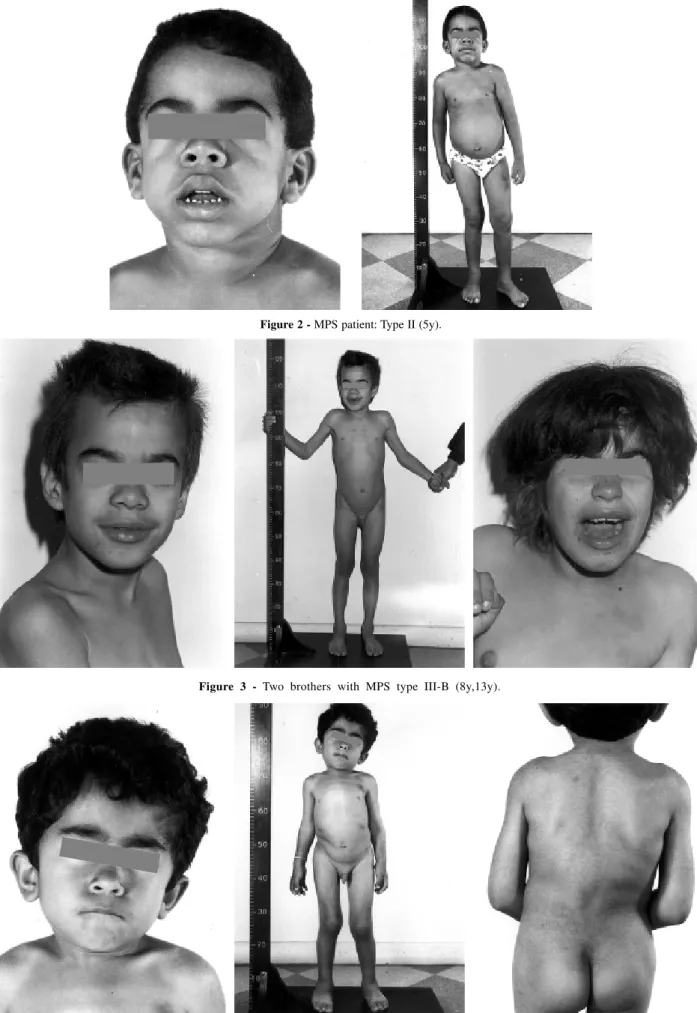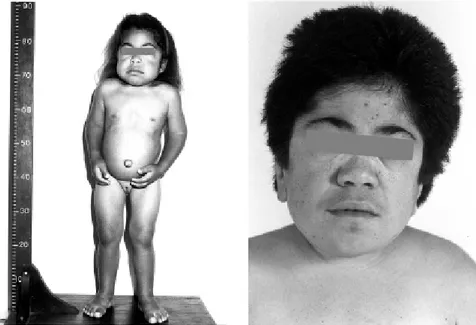From the Genetic Unit of the Department of Pediatrics, Hospital das Clínicas, Faculty of Medicine, University of São Paulo; Biochemistry Department of UNIFESP and Department of Genetics, Hospital de Clínicas, Porto Alegre.
CLINICAL AND LABORATORIAL STUDY OF 19
CASES OF MUCOPOLYSACCHARIDOSES
Lilian M. J. Albano, Sofia S. M. M.Sugayama, Débora R. Bertola, Carlos E. F. Andrade, Cláudia Y. Utagawa, Flávia Puppi, Helena B. Nader , Leny Toma , Janice Coelho , Sandra Leistner , Maira Burin , Roberto Giugliani and Chong A. Kim
RHCFAP/3026
ALBANO LMJ et al. - Clinical and laboratorial study of 19 cases of mucopolysaccharidoses. Rev. Hosp. Clín. Fac. Med. S. Paulo 55(6):213-218, 2000.
The mucopolysaccharidoses (MPS) are a heterogeneous group of inborn errors of lysosomal glycosaminoglycan (GAG) metabolism. The importance of this group of disorders among the inborn errors of metabolism led us to report 19 cases.
Method: We performed clinical, radiological, and biochemical evaluations of the suspected patients, which allowed us to
establish a definite diagnosis in 19 cases.
Results: Not all patients showed increased GAG levels in urine; enzyme assays should be performed in all cases with strong
clinical suspicion.The diagnosis was made on average at the age of 48 months, and the 19 MPS cases, after a full clinical, radiological, and biochemical study, were classified as follows: Hurler – MPS I (1 case); Hunter – MPS II (2 cases); Sanfilippo – MPS III (2 cases); Morquio – MPS IV (4 cases); Maroteaux-Lamy – MPS VI (9 cases); and Sly – MPS VII (1 case).
Discussion: The high relative frequency of Maroteaux-Lamy disease contrasts with most reports in the literature and could
express a population variability.
DESCRIPTORS: Mucopolysaccharidoses. Glycosaminoglycans. Lysosomal storage diseases.
The mucopolysaccharidoses (MPS) are a heterogeneous group of lysoso-mal storage disorders caused by the de-ficiency of enzymes involved in deg-radation of glycosaminoglycans, also named mucopolysaccharides. Its pat-tern of inheritance is autosomal reces-sive, except for MPS II, which is X-linked. The incidence of MPS may be as high as 1:10 000 live births, and Hurler syndrome is usually reported in the literature as the most frequently occurring type1,2.
There are at least 10 enzymes known to be required for the stepwise degradation of dermatan sulfate, heparan sulfate, keratan sulfate, and chondroitin sulfate, deficiencies of
which lead to a wide spectrum of a progressive and chronic clinical disor-ders (Table 1).
The importance of this group of disorders among the inborn errors of metabolism led us to report 19 MPS cases after clinical, radiological, and biochemical investigations, which al-lowed us to establish the definitive di-agnosis.
PATIENTS AND METHODS
The study was carried out over a period of six years (1994-1999). We could establish the definitive diagnosis, including the specific type of MPS, in 19 patients.
were indicated for all patients sus-pected.
A biochemical investigation was carried out according to the proposal of Leistner and Giugliani3, in suspected patients. Initially, the glycosaminogly-can (GAG) concentration in urine was measured, and the relative proportion of their components (dermatan sulfate, heparan sulfate, chondroitin sulfate, and keratan sulfate) was estimated.
The diagnostic enzyme assays were selected according to clinical suspicion and results of the biochemical investi-gation.
RESULTS
The biochemical investigation al-lowed the diagnosis of 19 MPS cases, classified as follows: Hurler – MPS I (1 case – 5.3%); Hunter – MPS II (2 cases – 10.5%); Sanfilippo – MPS III (2 cases – 10.5%; all type B); Morquio – MPS IV (4 cases – 21.1 %; all type A); Maroteaux-Lamy – MPS VI (9 cases – 47.4%) and Sly – MPS VII (1 case – 5.3%) (Fig. 1-5).
The average age at diagnosis was 48 months (ranging from 7 to 19 years), and the patients’ ages ranged
from 2 to 20 years.
Parental consanguinity was ob-served in 6 cases. Thirteen cases were sporadic, being the reminiscent familial. Most patients presented coarse fa-cial features (16/19 – 84%) and hepatosplenomegaly (12/19 – 63%). The frequency of obstructive airway disease was 53%, and corneal clouding was observed in 37%; gibbous lumbar vertebrae occurred in 58% of the cases, and joint stiffness occurred in 74%.
Cardiac abnormalities were ob-served in 9 cases (47%), including car-diac murmur (4/9 – 44%), mitral and tricuspid valvar reflux (2/9 – 22%), and septal defects (2/9 – 22%). A pericar-dium effusion (1/9 –11%) was ob-served in 1 case of Hurler syndrome.
Skeletal abnormalities were evident in 16 out of 18 cases radiologically studied (89%). We found the following main radiological findings: “J-shaped” sella turcica, dorsal kyphosis, broad and saber-shaped ribs, wedge-shaped beaking abnormality of the vertebral body, osteoporosis, increased diameter of tubular bones, angulation of the dis-tal end of the radius and ulna, narrow-ing of the proximal metacarpals, de-layed carpal bone age, and hip
abnor-Table 1 - Classification of the mucopolysaccharidoses.
MPS TYPE EPONYM ENZYME DEFECT
I Hurler a-L-iduronidase
II Hunter Iduronate 2-sulfatase
III-A Sanfilippo type A Heparan N-sulfatase III-B Sanfilippo type B a-N-acetylglucosaminidase
III-C Sanfilippo type C Acetyl-CoA: a glucosaminide N-acetyltransferase III-D Sanfilippo type D N-acetylglucosamine 6-sulfatase
IV-A Morquio type A Galactose 6-sulfatase IV-B Morquio type B b-galactosidase
VI Maroteaux-Lamy N-acetylgalactosamine 4-sulfatase
VII Sly b-glucuronidase
Figure 3 - Two brothers with MPS type III-B (8y,13y).
malities as a constriction above the ac-etabulum.
Developmental delay, a feature present in 42% of the cases (8/19), was observed in the Hurler, Hunter, and
Sanfilippo cases, and also in 2 Maroteaux-Lamy cases.
The clinical, radiological, and bio-chemical results are summarized in table 2.
DISCUSSION
The most frequent type of MPS is reported to be Hurler syndrome (MPS type I) with an estimated frequency of 1:50 000 to 1:132 0001,4,5,6,7. This fig-ure is probably underestimated, due to early deaths and diagnostic difficulties. Hunter syndrome is also reported to be frequent, but with lower incidence than Hurler syndrome. The clinical fre-quency of Morquio syndrome seems to be lower than that of Hurler and Hunter syndromes4.
Sanfilippo syndrome ranks among the most common types of MPS1. As there are not striking physical features accompanying the marked mental re-tardation of the Sanfilippo syndrome, Neulfeld and Muenzer (1995)2 believe that it is under diagnosed, considering the high incidence found in the Neth-erlands (1:24 000 live births) as a re-sult of the efforts employed to detect all cases.
Table 2 - Clinical, laboratory and radiologic findings in 19 patients.
Type SS MD Coarse CO Visc Gib JS Hirs Card Skel GAGS Enzymatic defect
I Hurler + + + + H/S + + + + + a-L-iduronidase
II Hunter - + + - H - + + - + Iduraonate 2-sulfatase
II Hunter + + + - H/S + + + + + Iduraonate 2-sulfatase
III-B Sanfilippo - + + - H/S - - - - - normal a-N-acetylglucosaminidase
III-B Sanfilippo - + + - H/S - - - - - § a-N-acetylglucosaminidase
IV-A Morquio - - + + - + - - + + Galactose 6-sulfatase
IV-A Morquio + - - - - - + - - + normal Galactose 6-sulfatase
IV-A Morquio + - - - - - + - - + normal Galactose 6-sulfatase
IV-A Morquio + - - - - + - - - + normal Galactose 6-sulfatase
VI Maroteaux-Lamy + - + - H/S + + + + + N-acetylgalactosamine sulfatase
VI Maroteaux-Lamy + - + - H/S - + + + + N-acetylgalactosamine ulfatase
VI Maroteaux-Lamy + - + - H/S + + + + + N-acetylgalactosamine sulfatase
VI Maroteaux-Lamy + - + + H/S + + + - + Normal N-acetylgalactosamine sulfatase
VI Maroteaux-Lamy - + + + H/S + + + - + N-acetylgalactosamine sulfatase
VI Maroteaux-Lamy - + + + H/S + + + - + N-acetylgalactosamine sulfatase
VI Maroteaux-Lamy + - + + H/S - + + + + N-acetylgalactosamine sulfatase
VI Maroteaux-Lamy + - + + - + + + + + N-acetylgalactosamine sulfatase
VI Maroteaux-Lamy - - + - H/S + + + + + N-acetylgalactosamine sulfatase
VII Sly + + + - H/S - - - - § § b-glucuronidase
Abrev:SS = short stature; MD = mental delay; Coarse = Coarse facies; CO = Corneal opacity; Visc = visceromegaly; Gib = gibbous vertebrae; JS = joint stiffness; Hirs = hirsutism; Card = cardiac abnormalities; Skel = skeletal abnormalities; § = not performed.
H/S = Hepatomegaly/Splenomegaly
Maroteaux-Lamy syndrome, does not have good estimates of its frequency, as it seems to be rare in most reports and as a considerable number of indi-viduals with Hurler-Scheie syndrome were classified in the past as having Maroteaux-Lamy syndrome 1.
Our results, in contrast to the litera-ture1,4,5,6,7,8,9, show a high proportion of Maroteaux-Lamy cases (47%). As there are few reports about MPS inci-dence in Brazil10,11, we believe that this significant proportion of MPS VI cases could be caused by population charac-teristics.
Our clinical investigation (Table 2) revealed short stature in 12/19 cases (63%) and normal growth in 7 patients: 1/2 Hunter; 2/2 Sanfilippo; 1/4 Morquio; 3/9 Maroteaux-Lamy. The
finding of abnormalities in the skeletal evaluation was the most consistent finding in all MPS types: 16/18 cases (88%), sparing only the 2 Sanfilippo patients.
Coarse facies was observed in 16/ 19 cases (84 %), (the exceptions were three Morquio patients). Hepatosple-nomegaly was detected in 14/19 cases (73%), not being found in 1 Maroteaux-Lamy case and in the 4 Morquio patients. Corneal opacity was observed in 7/19 cases (36%), and car-diac involvement was observed in 9/19 patients (47%).
Mental retardation was present in 8/ 19 cases (42%). Normal intelligence was present in all Morquio patients and 7/9 Maroteaux-Lamy cases (77%).
Clinical and radiological findings are fundamental for the diagnosis of a
MPS disorder. However, investigation of glycosaminoglycans and enzymatic studies are essential not only to estab-lish the definitive diagnosis but also to classify exactly the MPS type – infor-mation very useful for genetic counsel-ing and prenatal diagnosis.
The finding of normal urinary GAG levels in 5/17 patients (29%) is an in-dication that a normal urinary GAG pattern does not rule out the possibil-ity of a MPS disorder.
Diagnosis is not always easy, and confirmation is based on specific enzy-matic investigation. Therefore, both physicians and laboratory personnel should contribute their experience to a complete study of cases with a sus-pected MPS disorder, in order to con-duct a rapid and through investigation to reach an accurate diagnosis.
RESUMO RHCFAP/3026
ALBANO LMJ e col. - Estudo clínico e laboratorial de 19 casos de mucopolissacaridoses. Rev. Hosp.
Clín. Fac. Med. S. Paulo 55(6):
213-218, 2000.
As mucopolissacaridoses (MPS) constituem um grupo de erros inatos do metabolismo lisossomal dos glico-saminoglicanos (GAG) bastante hete-rogêneo. A importância das MPS le-vou-nos a relatar as características de 19 casos.
Método: Realizamos uma
avalia-ção clínica, radiológica e bioquímica, incluindo estudos enzimáticos, que nos permitiram estabelecer o diagnóstico definitivo em 19 casos.
Resultados: Nem todos os
pacien-tes apresentaram níveis elevados de GAG na urina, devendo os ensaios enzimáticos serem realizados em todos os pacientes com forte suspeita clíni-ca. O diagnóstico foi estabelecido em média aos 48 meses de idade e os ca-sos, após amplo estudo clínico, radio-lógico e bioquímico, foram classifica-dos como: Hurler – MPS I (1 caso);
Hunter – MPS II (2 casos); Sanfilippo – MPS III (2 casos); Morquio – MPS IV (4 casos); Maroteaux-Lamy – MPS VI (9 casos); e Sly – MPS VI (1 caso).
Discussão: A proporção
relativa-mente alta de MPS VI (Maroteaux-Lamy) contrasta com a maioria dos da-dos da literatura e pode expressar uma variabilidade populacional.
REFERENCES
1. WHITLEY CB The mucopolysaccharidoses. In: BEIGHTON P -McKusick’s Heritable disorders of connective tissue. 5th ed., St
Louis, Mosby, 1993. p367-499.
2. NEUFELD EF & MUENZER J - The mucopolysaccharidoses. In: SCRIVER CR, BEAUDET AL, SLY WS et. al. - The metabolic and molecular bases of inherited diseases. 7th ed. New York,
McGraw-Hill, 1995. p.2465-2494.
3. LEISTNER S & GIUGLIANI R - A useful routine for biochemical detection and diagnosis of mucopolysaccharidoses. Gen Mol Biol 1998; 21:163-167.
4. LOWRY RB & RENWICK DHG - Relative frequency of the Hurler and Hunter syndromes (letter). N Engl J Med 1971; 284:221-222. 5. SCHAAP T & BACH G - Incidence of mucopolysaccharidoses in Israel: is Hunter disease a Jewish disease? Human Genet 1980; 56 :221-226.
6. YOUNG ID & HUNTER PS - Incidence of Hunter’s syndrome. Human Genet 1982; 60:391-392.
7. HOPWOOD JJ & MORRIS CP - The mucopolysaccharidoses: diagnosis, molecular genetics and treatment. Mol Biol Med 1990; 7:381-404.
8. LOWRY RB, APPLEGARTH DA, TOONE JR et al. - An update on the frequency of mucopolysaccharide syndromes in British Columbia. Hum Genet 1990; 85:389
9. NELSON J – Incidence of the mucopolysaccharidoses in northern Ireland. Hum Genet 1997; 101:355-358.
10. GIUGLIANI R, DUTRA JC, BARTH ML et al. - Seven-year experience of a reference laboratory for the detection of inborn errors of metabolism in Brazil. J Inher Metab Dis 1991; 14:400-402. 11. COELHO JC, WAJNER M, BURIN M et al. - Selective screening of
10,000 high-risk Brazilian patients for the detection of inborn errors of metabolism. Eur J Pediatr 1997; 156:650-654.


